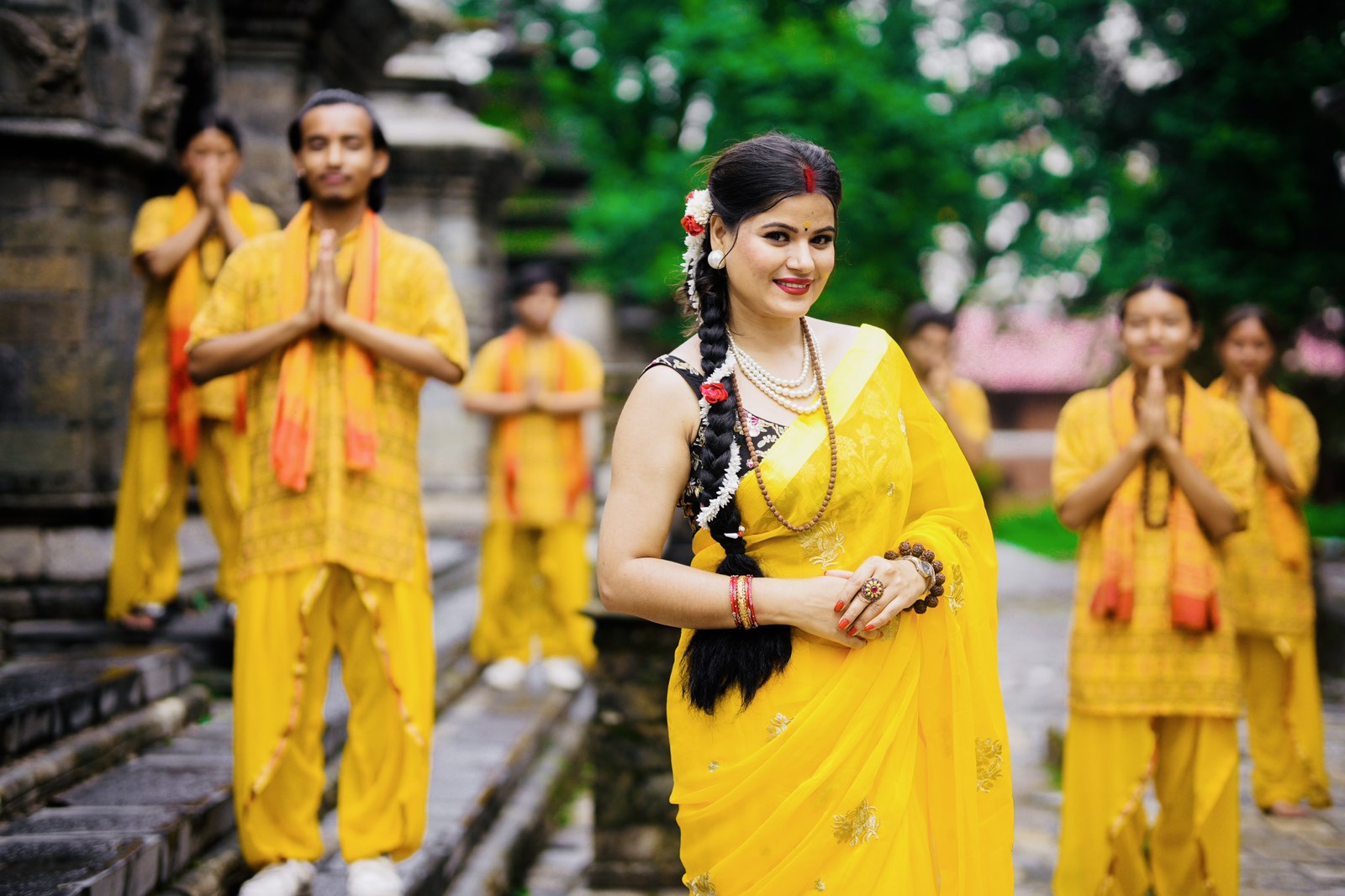“Saamb Sada Shiva Om”: A Soulful Devotional Tribute to Lord Shiva Released on Guru Purnima
Kathmandu:
‘Saamb Sada Shiva Om’ is a devotional hymn filled with deep reverence toward Lord Shiva. It is a prayer song that focuses especially on Pashupatinath, a powerful form of Shiva, offering him praise, devotion, and meditation. The mantra “Jai Bhole, Jai Baba Pashupatinath” resonates throughout the hymn, glorifying Lord Shiva’s greatness.
The hymn portrays Shiva as timeless—without beginning or end, birthless and deathless, the god of all gods, the embodiment of the Trimurti (Brahma, Vishnu, Maheshwar). It highlights Shiva’s form as Neelkantha, who consumed the deadly poison during the Samudra Manthan (churning of the ocean), his oneness with Goddess Yogamaya, and his supreme benevolent nature. The hymn deeply reflects upon these divine qualities through prayer, meditation, and devotion.
Each line of the hymn remembers various forms of Lord Shiva such as Shashi Shekhar, Gangadhar, Ashutosh, and Trinetra-dhari, inspiring devotees to offer complete surrender and focus their hearts and minds on the Lord. It conveys that through his third eye, Shiva can destroy ignorance and grant moksha (liberation) to all beings. That is why he is called Devadhidev (God of gods) and Sada Shiva (the Eternal One). The message is clear: through love, devotion, and knowledge, devotees can walk the path of peace and salvation.
By referring to Shiva as “the first dawn of creation,” the hymn identifies him as the primordial cosmic force that encompasses both the beginning and end of the universe. The sacred mantra “Om Namah Shivaya” is used to communicate a sense of divine serenity and spiritual awakening. It aims to instill love, compassion, and devotion in society. Om is considered the fundamental sound of the universe, intimately connected with Shiva. “Kar jodi naman chhe hey Shashi Shekhar” means bowing with folded hands to the moon-crowned Shiva, expressing heartfelt reverence.
The line “Let the mind always remain with the Lord” emphasizes unwavering focus on Shiva without distraction—urging continuous meditation. The chant “Jai Bhole… Jai Baba Pashupatinath” praises Bhole Nath, the simple and kind-hearted Lord, and Pashupatinath, the guardian of all living beings. As “the granter of liberation to all creatures,” Shiva bestows moksha upon any devotee who surrenders with true faith.
The name “Ashutosh” reflects how easily pleased Shiva is—granting boons even with the smallest act of devotion. “Gangadharaya Hey Mahadev” praises the form of Shiva who holds the Ganga, representing patience, compassion, and the desire for universal welfare. “Devbhoomi yo shastra kahani, Shiva nai srishti ko pahilo bihan” (This land of the gods, as per scriptures, marks the first dawn of creation by Shiva) honors places like Nepal and Kashi as sacred lands.
“Let the inner heart call out, for Pashupatinath’s glory is infinite”—urges true internal devotion rather than external appearances. “Spreading love in all hearts, walking the path of wisdom and devotion” reflects that true Shiva bhakti (devotion) is not just ritual or fear-driven, but guided by love and knowledge.
“Sing the praises of Umapati (Shiva, husband of Parvati), and rejoice in the chant of ‘Om Namah Shivaya’” calls on devotees to lose themselves in divine bliss through singing and chanting.
Thus, ‘Saamb Sada Shiva Om’ is not merely a devotional song; it is a spiritual experience, a meditative journey that shows the path of love, surrender, knowledge, and liberation. It highlights the sacred connection between the soul and the Supreme Being. Combining scripture, music, and faith, this hymn offers not just religious inspiration but spiritual growth and upliftment. For devotees of Pashupatinath, it becomes a symbolic devotional expression.
The soulful hymn, rich with these divine qualities and messages of Mahadev, was released on the auspicious occasion of Guru Purnima. Coincidentally, Shravan month also began that very day, according to the lunar calendar—making the release especially timely. Sung by Babina Bhattarai and scholar Dr. Ramesh Pokhrel, with music composed by Mahesh Gyawali and lyrics by Narad Pokhrel, the song was released through Babina Bhattarai’s own spiritual YouTube channel ‘Shree Bhajans’. The song is arranged by Binod Kumar Bhujel, and it was recorded at Acoustic Nepal Studio by Dil Samarpan and Rajbabu Tharu, with mixing and mastering by Prakash Mishra.
In the video, singer Babina herself is featured, appearing as a devoted female follower of Shiva, filmed in the premises of Pashupatinath under the direction of AJ Aju. Deeply immersed in devotion, she appears to lose herself entirely in the hymn, as though Lord Shiva himself has manifested during the performance. Her appearance—traditional attire and sacred vermilion—represents the ideal of a spiritually devoted woman. Dr. Ramesh Pokhrel and a group of devotees are also seen in the video. AJ Aju handled the cinematography, while Anil Bist Salyani managed editing and color grading. Narad Pokhrel is the producer and lyricist of the hymn, and Rojina Shrestha did the makeup and styling.
On the occasion of Guru Purnima, singer Babina Bhattarai expressed confidence that Nepalese devotional music lovers would appreciate this heartfelt hymn. She also shared her intention to regularly bring more diverse spiritual songs through her channel ‘Shree Bhajans’, and requested viewers to subscribe, like, comment, and share in support. She thanked all spiritual-minded individuals who contributed through audio and visual means and offered her deep gratitude and respect to them.
Lyricist Narad Pokhrel, explaining the meaning of the title, said:
“‘Saamb Sada Shiva’ is derived from Sanskrit. ‘Saamb’ means ‘Sa + Amba’, which refers to being ‘with Amba’ (i.e., with Parvati). ‘Sada Shiva’ means ‘Eternal Shiva’, the compassionate, benevolent, and peaceful aspect of the Lord. Thus, ‘Saamb Sada Shiva’ refers to the eternal Shiva who always remains with Parvati. This name represents the form of Lord Shiva that embodies the union of Shiva and Shakti (energy), where one is incomplete without the other.”
Singer and composer Babina Bhattarai, a strong believer in divine devotion, has previously released several devotional songs dedicated to Lord Krishna, Lord Rama, and Lord Shiva. She has also lent her melodious voice to many Nepali modern songs, ghazals, and classical compositions. Her contribution to spirituality and music is highly commendable. She expresses her commitment to continue promoting devotion and divine consciousness through music in the days to come.




Rajesh Thapa Elected Unopposed as President of Muktinath Corp.
December 14, 2025
Construction Progress of Dudhaura Bridge and Kalaiya-Matirwa Road
December 12, 2025
‘We Did Not Run Away’: Dhurmus Clarifies Reason Behind His US Visit
December 12, 2025


-1765361949.jpg)
-1765187354.jpg)
-1765182231.jpg)
-1764836796.jpg)
-1764755284.jpg)
-1764659377.jpg)



